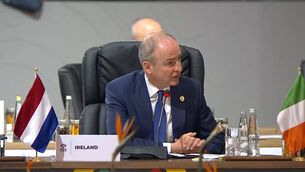Murray victim criticises his early release from prison

The woman, who spoke on condition of anonymity, said John Murray, 83, a former Labour city councillor, should have served a full year in prison following his conviction last December.
“All along, I just wanted justice,” she said. “When we took this on, we didn’t know if he would do time.
“He got six years with five suspended and now he’s getting out after nine months.
“From what we hear, he is still fit and healthy and was still driving the week before the trial last year. I just think he will go back to enjoying his life.
“I don’t understand this time off for good behaviour system, especially after he got so much of his prison sentence suspended,” she said.
“If what was left after all the suspensions was a year in prison, then he should have done at least a year.”
Mr Murray, from Gregg Rd in Cork, was found guilty by a jury after a trial at Cork Circuit Criminal Court last November of sexually assaulting the then teenager in 1996. He had denied the charges but he was found guilty on five counts.
On December 1 last, Judge Seán Ó Donnabháin imposed a two-year sentence on each of four counts of sexual assault, with the last year suspended on each count. He further imposed a concurrent, four-year sentence on one of the counts with the last three years suspended.
The net effect was that Murray was jailed for one year.
However, the woman who brought the complaint said she was advised he was due to be released from prison tomorrow.
“I was glad he got jail time, any time, but when already he got five years suspended, surely that was enough,” she said.
“I realise that there is only three months in the difference but it makes a joke of the system.
“Cork is a big city but a very small place. I saw him around town in the lead up to the trial. I don’t want to run the risk of seeing him again.”
The woman, who described herself as “a victor”, not a victim, said despite the ordeal of the trial and having to take the stand to give evidence, she would encourage other abuse victims to come forward.
“I can understand why people would find it hard to bring these cases,” she said.
“There are loads of things wrong with the court system for cases like this. It is intimidating
“I didn’t see the book of evidence and didn’t know what defence his side would mount.
“I had no time to prepare and only met the prosecution barrister the morning the trial started.
“But I was told from an early age that you can never, ever, be caught out when you are telling the truth.
“And that’s what I did. I knew what answers to give, and I was consistent because I was telling the truth.
“It’s never ever too late to come forward. It is a hard battle and you need support but I had great support from the important people in my family.”
She said the end of the trial allowed her to start living her life again.
“This had weighed me down for most of life. But I’ve never felt better. I don’t want that man to ever affect my life again,” she said.
The Murray trial was one of the most high-profile trials in Cork last year.
It emerged after his conviction that, during the trial, a visiting Augustinian friar asked mourners at a funeral Mass in the city to pray that Murray would be found not guilty.
Bishop of Cork and Ross, Most Rev Dr John Buckley, reacted with a statement and said the diocese did not stand over the comments and regretted the obvious hurt they had caused.
The bishop’s intervention prompted a swift apology from the Augustinian order, which described the prayer as “wholly inappropriate”. Its provincial also admitted that the friar’s intervention caused great distress.
Controversy flared a week after Murray’s sentencing when city councillors were asked to consider removing aphotographic portrait of Murray from a prominent location in City Hall.
Councillors stalled for a week on making a decision before the woman herself made direct contact with then Lord Mayor, Catherine Clancy.
It is understood she made a powerful and impassioned plea to Ms Clancy, setting out her views on the matter.
Following a meeting of party whips, a “consensus decision” was made to remove the photograph from the corridor outside the mayoral office.
Several councillors had argued privately that removing the portrait would be like airbrushing history.
But others, mostly younger councillors, said given the nature of the offence, councillors must be conscious of the sensitivities involved of continuing to display a photograph of a convicted sex offender in such a public area.













